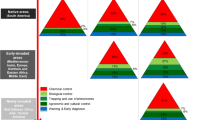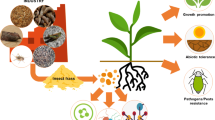Abstract
A simple and inexpensive method that uses freshly excised green bolls (~10 d old) of cotton (Gossypium hirsutum L.) is developed for laboratory rearing of pink bollworm, Pectinophora gossypiella (Saunders). The adult females of pink bollworm preferred to lay eggs on the bracts and sometimes also on the rind of bolls, either singly or in a group of 2–3 eggs. The larvae fed and pupated within the bolls itself. The developing larvae can be removed at any stage of their development for morphometric studies, conducting bioassays, etc. The newly formed pupae can easily be removed and maintained till adult emergence. The egg hatching and adult emergence were 89.94 ± 3.61% and 92.32 ± 2.34%, respectively with a mean fecundity of 203.73 ± 38.83 per female and a mean generation time of 34.43 ± 0.61 days. All the biological parameters of pink bollworm reared by this method were reasonably comparable with literature reports on its rearing using different natural as well as artificial diets. The insect raised by this method retained its ability to infest field grown cotton. We could successfully raise up to five generations of pink bollworm by this method with the input of one labourer. This method is easily applicable and less expensive, and it would be highly useful in understanding the pink bollworm phenology mediated through alterations and or aberrations in nutritional status of its host crop i.e. cotton.




Similar content being viewed by others
References
Adkisson, P. L. (1961). Fecundity and longevity of the adult female pink bollworm reared on natural and synthetic diets. Journal of Economic Entomology, 54(6), 1224–1227.
Attique, M. R., Ahmad, Z., Mohyuddin, A. I., & Ahmad, M. M. (2004). Oviposition site preference of Pectinophora gossypiella (Lepidoptera: Gelechiidae) on cotton and its effects on boll development. Crop Protection, 23(4), 287–292.
Beura, S., Ranvir, S., & Sing, R. (2011). Effect of sucrose pulsing before storage on postharvest life of Gladiolus. Journal of Ornamental Horticulture, 4(2), 91–94.
CABI. (2017). Invasive species compendium: Pectinophora gossypiella (pink bollworm). Available online at https://www.cabi.org/isc/datasheet/39417#70AF7142-7A8B-4F36-A0BA-4F14FA270EED. Accessed on 21/11/2017.
Cacayorin, N. D., Domingo, E. O., Sensano, D. R., Solsoloy, A. D., & Solsoloy, T. S. (1992). Occurrence and biology of pink bollworm, P. gossypieella (Saunders) on cotton. Cotton Research Journal Philippines, 5, 66–75.
Cao, DinhDung. (2013). Factors controlling vase life of Waxflowers (Chamelaucium Desf. Varieties and hybrids). School of Science, Department of Environment and Agriculture, Thesis presented for the Master of Philosophy of Curtin University October 2013, pp. 1–107.
Cleland, E.E., Chuine, I., Menzel, A., Mooney, H.A., & Schwartz, M.D. (2007). Shifting plant phenology in response to global change, tree, 22, 357–365.
Dharajothi, B., Naik, V. C. B., Kranthi, S., Kranthi, K. R., & Valarmathi, R. (2016). Viable mass production method for cotton pink bollworm, Pectinophora gossypiella (Saunder). The Journal of Basic & Applied Zoology, 73, 9–12.
Dhurua, S., & Gujar, G. T. (2011). Field-evolved resistance to Bt toxin Cry1Ac in the pink bollworm, Pectinophora gossypiella (Saunders) (Lepidoptera: Gelechiidae), from India. Pest Management Science, 2011(67), 898–903.
Fand, B. B., Nagrare, V. S., Gawande, S. P., Nagrale, D. T., Naikwadi, B. V., Deshmukh, V., Gokte-Narkhedkar, N., & Waghmare, V. N. (2019). Widespread infestation of pink bollworm, Pectinophora gossypiella (Saunders)(Lepidoptera: Gelechidae) on Bt cotton in Central India: A new threat and concerns for cotton production. Phytoparasitica, 47(3), 313–325.
Fry, R. (2014). Examples of the difference between male and female pupae. Available online at: http://www.ukleps.org/sexingpupae.html. Accessed 28 Oct 2019.
Gregory, P. J., Johnson, S. N., Newton, A. C., & Ingram, J. S. I. (2009). Integrating pests and pathogens into the climate change/food security debate. Journal of Experimental Botany, 60, 2827–2838.
Gutierrez, A. P., Pointi, L., d’Oultremont, T., & Ellis, C. K. (2008). Climate change effects on poikilotherm tritrophic interactions. Climate Change, 87, 67–92.
House, O. H., Czuba, J. L., Gall, M., & Hugh, D. (1969). Chemistry of carbanions. XVIII. Preparation of trimethylsilyl enol ethers Olmstead. Journal of Organic Chemistry, 34(8), 2324–2336.
Julkunen-Tiitto (2015). Assessing the response of plant flavonoids to UV radiation: an overview of appropriate techniques, Photochemistry Reviews April 2015, Volume 14, Issue 2, pp 273–229.
Kostandy, S. N., & Rashad, A. M. (1997). Effect of two different food kinds (cotton plant flowers and bolls) on certain biological aspects of pink bollworm Pectinophora gossypiella (Saunders). Annals of Agricultural Science, Cairo, 42, 321–328.
Macfadyen, S., McDonald, G., & Hill, M. P. (2018). From species distributions to climate change adaptation: Knowledge gaps in managing invertebrate pests in broad-acre grain crops. Agriculture Ecosystem Environment, 253, 208–219.
Malthankar, P.A., & Gujar, G.T. (2014). Dietary influence on the biology and the susceptibility of pink bollworm, Pectinophora gossypiella (Saunders) (Lepidoptera: Gelechiidae) to Cry1Ac toxin from Bacillus thuringiensis, Biopesticide International, 10(2), 152–159.
Miller, E., Stewart, F., Anna, L., & John, B. (1996). New method of processing diet for mass rearing pink bollworm, P. gossypiella Saunders (Lepidoptera: Gelichiidae). Journal of Agriculture Entomology, 13(2), 129–137.
Muralimohan, K., Kamath, P., Mohan, K. S., Ravi, K. C., Deeba, F., Sivasupramaniam, S., & Head, P. G. (2009). Mass rearing for the pink bollworm, P. gossypiella (Lepidoptera Gelechiidae) and its susceptibility to insecticidal Bt proteins. International Journal of Tropical Insect Science., 29(2), 102–107.
Naik, V. C. B., Kumbhare, S. Kranthi, S., Satija, U., Kranthi, K. R. (2018). Field-evolved resistance of pink bollworm, Pectinophora gossypiella (Saunders) (Lepidoptera: Gelechiidae), to transgenic Bacillus thuringiensis (Bt) cotton expressing crystal 1Ac (Cry1Ac) and Cry2Ab in India. Pest Management Science, 74, 2544–2554.
Ojha, A., Sowjanya Sree, K., Sachdev, B., Rashmi, M. A., Ravi, K. C., & Suresh, P. J. (2014). Analysis of resistance to Cry1Ac in field-collected pink bollworm, Pectinophora gossypiella (Lepidoptera:Gelechiidae), populations. Journal GM Crops & Food Biotechnology in Agriculture and the Food Chain, 5(4), 280–286.
Patana, R. (1977). Layered diet for pink bollworm rearing. United States Department of Agriculture, Agricultural Research Service, W-47, 10 pp.
Patil, S.B. (2003). Studies on management of cotton pink bollworm Pectionophora gossypiella (Saunders) (Lepidoptera: Gelechiidae). Ph.D. Thesis submitted to University of Agricultural Sciences, Dharwad, Karnataka, (India).
Peddu, H., Fand, B. B., Sawai, H. R., & Lave, N. V. (2020). Estimation and validation of developmental thresholds and thermal requirements for cotton pink bollworm Pectinophora gossypiella. Crop Protection, 127, 104984. https://doi.org/10.1016/j.cropro.2019.104984.
Powar, V., Bhargava, B., & Ghumare, V. (2014). Study on waxing of cut foliage post harvest life of few ornamental species. Journal of Applied and Natural Science, 6(2), 619–624.
Pun, U. K., & Ichimura, K. (2003). Role of sugars in senescence and biosynthesis of ethylene in cut flowers. Japan Agricultural Research Quarterly, 37(4), 219–244.
Raulston, J. R. (1971). A practical diet containing cotton seed for rearing pink bollworm. Journal of Economic Entomology, 64, 1021–1023.
Singh, R., & Agrawal, R. A. (1988). Role of chemical components of resistant and susceptible genotypes of cotton and okra in ovipositional preference of cotton leafhopper. Procedings of Indian academy of science (Animal science), 97, 545–550.
Van Doorn, W. G. (2004). Is petal senescence due to sugar starvation? Plant Physiology, 134, 35–42.
Vanderzant, E. S., Reiser, R., & Ivy, E. E. (1956). Methods for the mass rearing of the pink bollworm. Journal of Economic Entomology, 49(4), 559–560.
White, T. C. R. (1984). The abundance of invertebrate herbivores in relation to the availability of nitrogen in stressed food plants. Oecologia, 63, 90–105.
Acknowledgements
This study is a part of the research project titled “Investigations into exacerbation of pest status of cotton pink bollworm Pectinophora gossypiella (Saunders) in the context of climate change through development of phenology model (Project Code- OXX04036)” of the Division of Crop Protection, ICAR-Central Institute for Cotton Research. The authors gratefully acknowledge financial support from Indian Council of Agricultural Research, New Delhi. We are thankful to the Director, ICAR-CICR, Nagpur for providing all the necessary facilities and extending his cooperation and support to carry out present investigations.
Author information
Authors and Affiliations
Corresponding author
Ethics declarations
Conflict of interest
Authors of this manuscript declare that there exists no any conflict of interest with respect to the content of this manuscript. All the sources of information accessed have been duly acknowledged.
Additional information
Publisher’s note
Springer Nature remains neutral with regard to jurisdictional claims in published maps and institutional affiliations.
Highlights
1. A new method for laboratory rearing of cotton pink bollworm is presented
2. The pink bollworm was successfully reared with stable biological parameters over five generations
3. The proposed method can be useful in the case of various experimental tests in laboratory
Rights and permissions
About this article
Cite this article
Fand, B.B., Nagrare, V.S., Deshmukh, V. et al. A simple and low-cost laboratory rearing technique for pink bollworm, Pectinophora gossypiella (Suanders) (Lepidoptera: Gelechidae) using detached green bolls of cotton. Phytoparasitica 48, 25–33 (2020). https://doi.org/10.1007/s12600-019-00779-2
Received:
Accepted:
Published:
Issue Date:
DOI: https://doi.org/10.1007/s12600-019-00779-2




